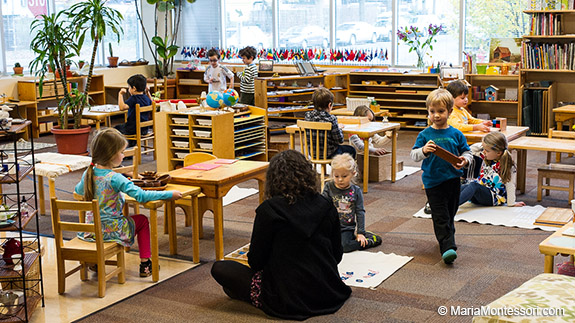
October 30, 2022
“Your children go to Montessori school? I heard that’s fine for preschoolers, but when they are older, won’t they need something different?”
I would guess that many of you have been asked questions similar to this on more than one occasion. It is an indication of the positive reputation Montessori enjoys as a preschool program, but also the relative lack of understanding of its relevance for older ages. It also asserts that older children need a different environment from the little ones. And indeed they do, which is why the Montessori elementary environment is designed so differently from that for the younger ages. What most of these people mean by “something different,” however, is the teacher-centered, one-size-fits-all conventional model of education in which they themselves grew up.
Conventional education is an outgrowth of the industrial revolution, and some psychologists and educators even refer to it as a “factory model.” At its core, it is an artificial construct based on efficiency, like the assembly line. Everyone doing the same thing at the same time on an adult-devised schedule would seem efficient, wouldn’t it? Unfortunately, children are not widgets to be assembled, and that system fails to take into account the changing needs and characteristics of children’s developmental stages, much less the needs of individuals. Therefore it not only leaves some children behind, but it doesn’t do a good job of matching up with the developmental needs and characteristics of any. For generations, students have struggled to conform to it, like so many round pegs forced into square holes.
Dr. Montessori, on the other hand, flipped this model on its head. She didn’t begin with an efficiency model or any other model or mental construct for that matter. Instead, she began by observing how children develop and asking herself the question, “What kind of learning environment would respond best to the changing needs and characteristics at each stage?” Instead of making children conform to an environment, she made the environment conform to the child!
Like many scientists since, she observed common developmental characteristics within roughly six-year increments, which she referred to as the planes of development including early childhood (birth to six), elementary (6-12), and adolescence (12-18). For each plane of development, then, there should be a unique learning environment, reflecting the requirements of that plane.
For example, she noticed that children at the age of 2 or 3, or 4 are very independent and individualistic and learn best through the use of their own hands on their own activity. “Individual activity is the one factor that stimulates and produces development and independence,” she said, referring to this age. Therefore, each child in a Montessori toddler or primary (3 to 6-year-old) environment has the opportunity to identify a workspace on a rug or table, free from interference or interruption. Contrast this to the conventional preschool, where children are constantly asked to share, which goes against children’s very nature at this age, and gives rise to struggles for possession so common in those environments.
That nature changes during the next plane of development as the elementary child becomes intensely social. Oddly enough, this is when children in conventional schools are confined to desks and told to neither talk nor share! Any observer in a Montessori school will notice the difference: in primary, children are largely engaged in independent or parallel activities, whereas rarely is an elementary child working alone. In the primary, lessons are given one-on-one for the most part, whereas in elementary the lessons are nearly always given to a group. And in elementary it is groups of children you see working as teams on projects, conducting research, or using materials. Once again it is clearly the case that in traditional elementary schools children are forced to conform to environments that are counter to their nature, while in Montessori it is the environment that conforms to them.
I could give many, many more examples, but there simply isn’t room here for a full explication of the characteristics of each plane of development and the way the Montessori environments change in response to them while other forms of education do not. Fortunately, you can visit a Montessori school close to you and experience the changing environments firsthand. The more you learn about Montessori and child development, the better you’ll be able to answer that question: “when they are older, won’t they need something different?” “You’re right,” you can say, “they need something different because they are different. But, the different thing they need is still Montessori!”